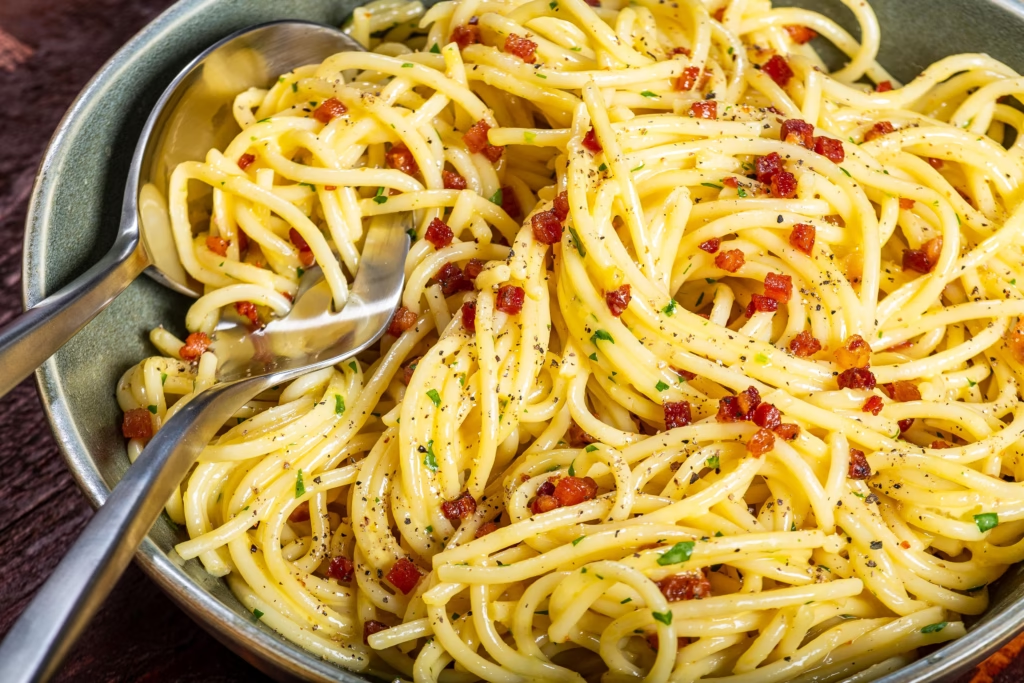Spaghetti Carbonara: The Quintessential Italian Comfort Food

Few dishes in Italian cuisine evoke as much admiration and debate as spaghetti carbonara. This Roman classic, with its creamy texture, smoky flavor, and simple ingredients, has a timeless appeal that transcends borders. Despite its apparent simplicity, spaghetti carbonara demands respect for tradition and attention to detail to truly shine. In this article, we delve into its history, ingredients, techniques, and the nuances that make it a beloved favorite across the globe.
The Origins of Spaghetti Carbonara
The history of spaghetti carbonara is as rich and intriguing as its flavor. While the dish is now considered a staple of Roman cuisine, its origins are relatively recent compared to other Italian classics. The exact history remains a subject of culinary debate, but the most widely accepted theory traces its roots to the mid-20th century during World War II.
As the story goes, American soldiers stationed in Italy brought rations of powdered eggs and bacon, which Italian cooks combined with local pasta and cheese. Over time, this improvised dish evolved into the carbonara we know today, using fresh eggs, guanciale (cured pork jowl), and Pecorino Romano cheese. The name “carbonara” is thought to derive from “carbonaro,” meaning charcoal burner in Italian, possibly referencing the hearty and satisfying meal enjoyed by workers in the Apennine mountains.
The Key Ingredients
The beauty of spaghetti carbonara lies in its simplicity. With only a handful of ingredients, the quality and authenticity of each component are paramount:
- Spaghetti: The traditional pasta choice for carbonara, spaghetti’s smooth surface and firm texture perfectly capture the creamy sauce. Other pasta varieties like rigatoni or bucatini can also be used, but spaghetti remains the classic.
- Guanciale: This cured pork jowl is the cornerstone of authentic carbonara. Its rich, fatty flavor and slightly chewy texture set it apart from substitutes like pancetta or bacon.
- Eggs: The sauce’s creaminess comes solely from eggs—no cream is used in the authentic recipe. A combination of whole eggs and yolks is typically used for the perfect balance of richness and silkiness.
- Pecorino Romano: This hard, salty cheese provides the dish’s distinctive tang. Parmesan can be used in a pinch, but it lacks the bold flavor of Pecorino Romano.
- Black Pepper: Coarsely ground black pepper adds a subtle heat and aromatic depth, rounding out the dish’s flavors.
Step-by-Step Recipe for Spaghetti Carbonara
Creating spaghetti carbonara at home requires precision and technique. Follow these steps to achieve a restaurant-quality dish:
Ingredients (Serves 4):
- 400g (14 oz) spaghetti
- 150g (5 oz) guanciale, diced into small strips
- 3 large egg yolks and 1 whole egg
- 100g (3.5 oz) Pecorino Romano, finely grated
- Freshly ground black pepper
- Salt (for boiling the pasta water)
Instructions:
- Prepare the Pasta Water
- Bring a large pot of salted water to a boil. The water should taste slightly salty, but not overwhelmingly so, as the guanciale and Pecorino Romano will add saltiness to the final dish.
- Cook the Guanciale
- In a large skillet or frying pan, cook the guanciale over medium heat until it’s golden and crispy, rendering out its fat. This process takes about 5-7 minutes. Remove the pan from the heat and set it aside.
- Whisk the Eggs and Cheese
- In a mixing bowl, whisk together the egg yolks, whole egg, and grated Pecorino Romano until smooth. Add a generous amount of freshly ground black pepper and mix well. Set aside.
- Cook the Spaghetti
- Add the spaghetti to the boiling water and cook until al dente, according to the package instructions. Reserve about 1 cup of the starchy pasta water before draining.
- Combine and Emulsify
- Return the skillet with the guanciale to low heat. Add the drained spaghetti to the skillet and toss to coat the pasta with the rendered fat.
- Remove the skillet from the heat and immediately pour in the egg and cheese mixture. Toss vigorously to coat the pasta, adding small amounts of the reserved pasta water as needed to create a creamy, silky sauce. Be careful not to scramble the eggs.
- Serve Immediately
- Plate the spaghetti carbonara and garnish with additional grated Pecorino Romano and a final grind of black pepper. Serve immediately for the best texture and flavor.
Tips for Perfect Carbonara
- Use Fresh Ingredients: The quality of guanciale, Pecorino Romano, and eggs directly impacts the dish’s flavor and texture.
- Control the Heat: Never pour the egg mixture into a hot pan over direct heat. Residual heat is sufficient to cook the eggs without scrambling them.
- Reserve Pasta Water: This starchy water is the secret to emulsifying the sauce and achieving the perfect consistency.
- Toss Thoroughly: Vigorous tossing ensures the sauce evenly coats each strand of spaghetti.
Common Variations and Missteps
While purists adhere strictly to the traditional recipe, variations have emerged over time. Adding garlic, cream, or other ingredients can create delicious interpretations, but they’re not authentic carbonara. Similarly, substituting guanciale with bacon or pancetta alters the flavor profile, making it less authentic but still tasty.
Common mistakes include overcooking the eggs, resulting in a scrambled texture, or adding too much salt, which can overpower the dish’s balance.
Cultural Significance
Spaghetti carbonara is more than just a meal; it’s a symbol of Italian culinary artistry and simplicity. In Rome, it’s a beloved staple, often enjoyed in trattorias alongside other Roman classics like cacio e pepe and amatriciana. The dish’s global popularity has made it a canvas for creativity, inspiring countless chefs to reinterpret it while still paying homage to its roots.
Pairing Suggestions
Carbonara’s rich, savory flavors pair beautifully with:
- Side Dishes: A simple arugula salad with lemon vinaigrette or roasted vegetables complements the dish without overshadowing it.
- Dessert: Finish with a classic Italian dessert like tiramisu or panna cotta to complete the meal.